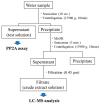First Report of Microcystis Strains Producing MC-FR and -WR Toxins in Japan
- PMID: 31505765
- PMCID: PMC6784158
- DOI: 10.3390/toxins11090521
First Report of Microcystis Strains Producing MC-FR and -WR Toxins in Japan
Abstract
Microcystins (MCs) are a group of cyclic heptapeptide hepatotoxins produced by Microcystis and several other genera of cyanobacteria. Many structural variants have been characterized using various methods such as liquid chromatography-mass spectrometry (LC-MS) analysis, enzyme-linked immunosorbent assay (ELISA) and protein phosphatase 2A (PP2A) inhibition assay. The representative MC, MC-LR, and related cyanobacterial toxins strongly inhibit PP2A activity and can therefore be assayed by measuring the extent of PP2A inhibition. However, these methods require reference toxin standards for the quantification and identification of known MCs. To obtain various MC-producing cyanobacterial strains, we surveyed and collected MC-producing cyanobacteria from environmental sources of water in Okinawa, Japan. Using a dual assay (LC-MS analysis and PP2A inhibition assay), we identified and isolated Microcystis strains producing five MC variants (MC-LR, -RR, -LA, -FR and -WR). Approximately 4 mg of MC-WR and -FR toxins were purified from the laboratory culture of the Microcystis isolate NIES-4344. Pure MC-WR and -FR variants were prepared for future use as toxin standards in LC-MS analysis. Phylogenetic analysis based on ftsZ revealed that the NIES-4344 strain belongs to the identified groups in Microcystis aeruginosa. This is the first report of Microcystis strains producing mainly MC-WR and -FR toxins in Japan.
Keywords: Cyanobacteria; Microcystis; environmental water; liquid chromatography–mass spectrometry; microcystins; protein phosphatase 2A inhibition assay.
Conflict of interest statement
The authors declare no conflict of interest.
Figures





Similar articles
-
High diversity of microcystins in a Microcystis bloom from an Algerian lake.Environ Pollut. 2016 Sep;216:836-844. doi: 10.1016/j.envpol.2016.06.055. Epub 2016 Jul 6. Environ Pollut. 2016. PMID: 27394081
-
Comparison of Microcystis aeruginosa (PCC7820 and PCC7806) growth and intracellular microcystins content determined by liquid chromatography-mass spectrometry, enzyme-linked immunosorbent assay anti-Adda and phosphatase bioassay.J Water Health. 2014 Mar;12(1):69-80. doi: 10.2166/wh.2013.088. J Water Health. 2014. PMID: 24642434
-
Comprehensive multi-technique approach reveals the high diversity of microcystins in field collections and an associated isolate of Microcystis aeruginosa from a Turkish lake.Toxicon. 2019 Sep;167:87-100. doi: 10.1016/j.toxicon.2019.06.006. Epub 2019 Jun 7. Toxicon. 2019. PMID: 31181296
-
Emerging high throughput analyses of cyanobacterial toxins and toxic cyanobacteria.Adv Exp Med Biol. 2008;619:539-57. doi: 10.1007/978-0-387-75865-7_24. Adv Exp Med Biol. 2008. PMID: 18461783 Review.
-
Algae blooms with resistance in fresh water: Potential interplay between Microcystis and antibiotic resistance genes.Sci Total Environ. 2024 Aug 25;940:173528. doi: 10.1016/j.scitotenv.2024.173528. Epub 2024 May 25. Sci Total Environ. 2024. PMID: 38802023 Review.
Cited by
-
Microcystin-LR in drinking water: An emerging role of mitochondrial-induced epigenetic modifications and possible mitigation strategies.Toxicol Rep. 2024 Sep 28;13:101745. doi: 10.1016/j.toxrep.2024.101745. eCollection 2024 Dec. Toxicol Rep. 2024. PMID: 39411183 Free PMC article. Review.
-
Detection and Characterization of Nodularin by Using Label-Free Surface-Enhanced Spectroscopic Techniques.Int J Mol Sci. 2022 Dec 12;23(24):15741. doi: 10.3390/ijms232415741. Int J Mol Sci. 2022. PMID: 36555384 Free PMC article.
-
Microcystins in Water: Detection, Microbial Degradation Strategies, and Mechanisms.Int J Environ Res Public Health. 2022 Oct 13;19(20):13175. doi: 10.3390/ijerph192013175. Int J Environ Res Public Health. 2022. PMID: 36293755 Free PMC article. Review.
-
A Mini-Review on Detection Methods of Microcystins.Toxins (Basel). 2020 Oct 4;12(10):641. doi: 10.3390/toxins12100641. Toxins (Basel). 2020. PMID: 33020400 Free PMC article. Review.
References
-
- Bartram J., Chorus I. Toxic Cyanobacteria in Water—A Guide to their Public Health Consequences, Monitoring and Management. CRC Press; Boca Raton, FL, USA: 1999.
-
- Meriluoto J., Spoof L., Codd G. A Handbook of Cyanobacterial Monitoring and Cyanotoxin Analysis. Volume 8 John Wiley & Sons; San Francisco, CA, USA: 2017.
-
- Jochimsen E.M., Carmichael W.W., An J.S., Cardo D.M., Cookson S.T., Holmes C.E., Antunes M.B., de Melo Filho D.A., Lyra T.M., Barreto V.S., et al. Liver failure and death after exposure to microcystins at a hemodialysis center in brazil. N. Engl. J. Med. 1998;338:873–878. doi: 10.1056/NEJM199803263381304. - DOI - PubMed
Publication types
MeSH terms
Substances
LinkOut - more resources
Full Text Sources
Research Materials

